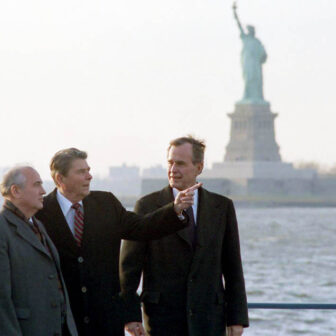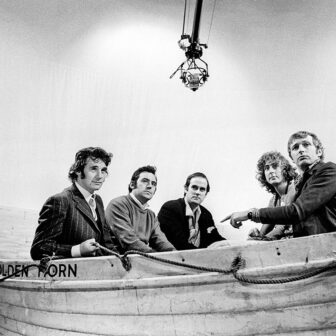“This is a true story.” It isn’t, of course, but we know that by now. The statement prefacing each episode of Fargo is an in-joke: the series plays with the genre expectations of true crime even as it sidesteps the fictional conventions of crime drama.
Across four seasons, with the fifth commencing this month, Fargo has created conventions of its own, one of which is to mix up the psychological profiles typically associated with violent acts and spin counterintuitive narratives accordingly. If the stories aren’t true then they could be, in the way truth is often said to defy the limits of credibility imposed on fiction.
To begin with, we have a cast of characters from a small regional community where it is important to be nice. “Minnesota nice,” as we’re informed at the start of the first episode of season five, is the term for a code of manners characterised by “an aggressively pleasant demeanour, often forced, in which a person is chipper and self-effacing, no matter how bad things get.” Nice people like to live regular, comfortable lives. They don’t like to take risks. Even the state’s distinctive accent, with its soothing, predictable intonations, communicates security.
People like these are naturally going to attract predators set on exploiting their inability to anticipate bad things happening. At least that’s the premise. As with all crime stories set in local communities, the predators come in two kinds: the home-grown, and the ones who cruise in from elsewhere, bringing new kinds of trouble. And the attraction between the predator and the prey cuts both ways, which is where the dynamic becomes perverse. The people who should be the victims in Fargo never quite turn out that way.
It’s this mutual engagement between predator and prey — or, perhaps more provocatively, between the sinister and the naive — that drives each season. Standard psychology would suggest that the more calculating, determined personality is going to be the catalyst, with an ingenuous counterpart co-opted as a mere pawn in the game, but that doesn’t account for fate itself, which is always an overarching influence.
Some killers know exactly what they intend, and plot accordingly, but others, the more interesting kind in this absurdist world, haven’t the slightest idea of what they are about to do until they’ve done it. Like season one’s failing insurance salesman, Lester Nygaard (Martin Freeman), seemingly intimidated by everyone he meets until his wife goads him more fiercely than usual and the hammer he’s holding develops a will of its own.
Questions of causality are always unresolved. When fate is the determining agent, the hammer might well be its instrument and Lester a mere channel. But Fargo also has real villains, affording opportunities for charismatic performances like those of Billy Bob Thornton as Lorne Malvo in the first season, David Thewlis as V.M. Varga in the third, and now Jon Hamm as fundamentalist cowboy sheriff Roy Tillman.
Apex predators might have cunning and sadism woven into their DNA but their blind spot is an incapacity to believe in anything other than the force of their own will. Fate, ever a trickster, has the capacity to outwit any of them.
Season five, under the direction of series creator Noah Hawley, opens in a school hall festooned with Halloween pumpkins for a presentation by the Fall Festival Planning Committee. For whatever reason (if there is one, we aren’t to learn it at this point) the meeting has turned into an all-out brawl. A terrified woman cringes in her seat, trying to shield her child from the melee.
Dot Lyon (Juno Temple) is a diminutive presence, seemingly fragile and surely “nice.” She makes pancakes for breakfast and meatloaf for dinner, serves on the school library committee, knits in front of daytime TV and is adored by her nerdy husband, Wayne (David Rysdahl). Under threat, though, she whips out a taser or turns a hairspray can into a flame thrower.
After fighting her way out of the school hall Dot undergoes the embarrassment of police arrest and is released just in time for a formal dinner with her wealthy mother-in-law Lorraine (Jennifer Jason Leigh). Lorraine, a formidable matriarch, kicks off the festive season with a photoshoot for the family Christmas card in which she and her inner circle pose with automatic firearms. Over dinner, she makes carping remarks to her daughter in law, who plays Minnesota nice.
Somewhere out of town, around a table in an open paddock on a vast cattle ranch, another family meal is being presided over, this one by Sheriff Tillman, who leads the company in saying grace with joined hands. True to the stereotype, he rides the property in a ten-gallon hat and supervises the training of horses in a massive barn. But that’s not all he supervises. His employees include a couple of hired killers and a mistress who engages in hardcore roleplay on demand.
Tillman’s obsession, though, is his missing wife, who suddenly appears after ten years when her photo is registered on the state law enforcement database after she is fingerprinted following the school hall riot.
Between that vengeful ex-husband and her gun-toting mother-in-law, Dot has her work cut out for her. She goes about it assiduously, creating a household defence system involving a lot of crushed lightbulbs. As if the dice are not already sufficiently loaded against her, an apparently supernatural being arises during a Gothic Halloween ritual and stalks abroad, bloody from head to foot.
What kind of story are we in here? Figuring that out is detective work for the audience.
If the mix of ingredients is verging on the preposterous, the dramatic tension is always in sure hands, with a terse and witty script from Hawley and Lee Edward Colston, wonderful cinematography from Dana Gonzales and his team and, as always with Fargo, actors of genius in the lead roles. •




